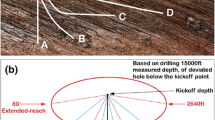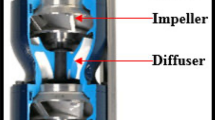For oil wells with high sand content, traditional oil well pumps easily get stuck. Increasing the gap between the plunger and the pump cylinder can effectively prevent the sticking, but the gap leakage also increases, resulting in a decrease in the volumetric efficiency of the pump. As shown in this paper, when a rectangular groove is formed in the plunger of the oil well pump, it can significantly reduce the leak rate. In order to reveal the flow resistance mechanism of the gap seal structure with rectangular groove and the reasonable design of the seal structure parameters, the flow characteristics in the gap seal structure with rectangular groove are studied by CFD technology. The results show that the gap seal structure with rectangular groove reduces the leakage amount by 87% compared with the prototype gap seal structure. The optimal number of rectangular grooves is 3-4. The sealing effect of the rectangular groove at the inlet of the pump is better than that at the pump outlet. The rectangular groove spacing has little effect on the leak rate.







Similar content being viewed by others
References
Liu Yang and Chen Guanrong, “Optimal parameters design of oilfield surface pipeline systems using fuzzy models.”Inform. Sci.,120(1), 13-21 (1999).
Liu YangÿCheng Qinglinet al., “Multi-objective optimization of energy consumption in crude oil pipeline transportation system operation based on energy loss analysis,” Neurocomputing, 332(7), 100-110 (2019).
R Kirk, S. Gordonk and K. Baheti, “Evaluation of floating ring seals for centrifugal compressors using the finite element method,” Trans. ASME, 121(1), 131-136 (1999).
T. W. Ha, Y. B. Lee, and C. H. Kim, “Leakage and rotor dynamic analysis of a high-pressure floating ring seal in the turbo pump unit of a liquid rocket engine,” Tribol. Int., 35(5), 153-161 (2002).
W. B. Duan, F. Chu, C. Kim, and Y. Lee, “A bulk-flow analysis of static and dynamic characteristics of floating ring seals,” Tribol. Int., 40(3), 470-478 (2007).
X. X. Zhang, M. M. Hao, and S. G. Xiang, “Performance analysis of the spiral groove floating ring seal based on CFD analysis,” Lubric. Eng.., 34(5), 72-75 (2009).
J. A. Demko and D. L. Rhode, “The prediction and measurements of incompressible flow in a labyrinth seal,” J. Eng. Gas Turbines Power, 33(2). ,18-20 (1989).
M. M. Sindir,”Impeller, shroud to casing leakage flow simulations in the space shuttle main engine hinge pressure foal pump,”HeatTransf. Fluid Flow Rotor. Mach., 33(5), 411-423 (1987).
E. A. Baskharone and N. J. Wyman, “Primary/leakage flow interaction in a pump stage.” J. Fluid Eng., 121(4), 133-138(1999).
M. Lu, “Research and simpatico on the gap type servo hydraulic cylinder seals,”Thesis, Wuhan University of Science and Technology, Wuhan (2010).
X. L. Liu and P. Yang. “Analysis of power law fluid thermal elastohydrodynamic lubrication,” Lubric. Eng., 32(8), 19-23(2007).
Z. H. Li, “The simulation study on the clearance seal of the directional slide valve and the opening process of one-way valve of the water injection and booster pump,” Thesis, Daqing Petroleum Institute, Daqing (2010).
R. Jiang. “Study on sealing performance of clearance seals,” Thesis, Northeast Petroleum University, Daqing (2012).
V Yakhot and S. Orszag, “Renormalization group analysis of turbulence basic theory,” J. Sci. Comput., 1, 43-51 (1998).
G. X. Cui, C. X. Xu, and Z. S. Zhang, “Progress in large eddy simulation of turbulence flows,”Acta Aerodyn. Sin., 2(22),121-129 (2004).
H. Chen and X. Z. Sun, “Investigation in the leakage and friction of low friction pump,” Clin. Pet Mach., 41(3), 11-14 (2013).
J. Jiang, G. Y. Zhou, L. C. Zeng, C. C. Zhan, and S. G. Fu, “Simulation and analysis of leakage for clearance seal of hydraulic cylinder,”Lubric. Eng., 38(7), 75-79 (2013).
H. K. Versteeg and W. Malalasekera, An Introduction to Computational Fluid Dynamics. The Finite Volume Method, Wiley, NewYork (1995).
B. Lauder and D. Spalding, Mathematical Models of Turbulence, Academic Press, Waltham (1972).
Acknowledgements
This project was funded by Natural Science Foundation of Heilongjiangprovince (No.LH2019E018), China Postdoctoral Science Foundation (No.2018T110268; No.2018M641804), Natural Science Foundation of China (No.51974327: No.51774091: No.51607035), and Daqing Science and Technology Plan Project (No.2d_2019_20).
CONFLICT OF INTEREST
The authors declare that there are no conflict of interest anong themselves.
Author information
Authors and Affiliations
Corresponding authors
Additional information
Translated from Khimiya i Tekhnologiya Topliv i Masel, No. 2, pp.76 — 82, March—April, 2020.
Rights and permissions
About this article
Cite this article
Tan, C., Feng, G., Feng, Zm. et al. Leakage Flow Mechanism of Gap Seal Structure of Oil well Pump with Rectangular Groove. Chem Technol Fuels Oils 56, 243–253 (2020). https://doi.org/10.1007/s10553-020-01135-5
Published:
Issue Date:
DOI: https://doi.org/10.1007/s10553-020-01135-5




